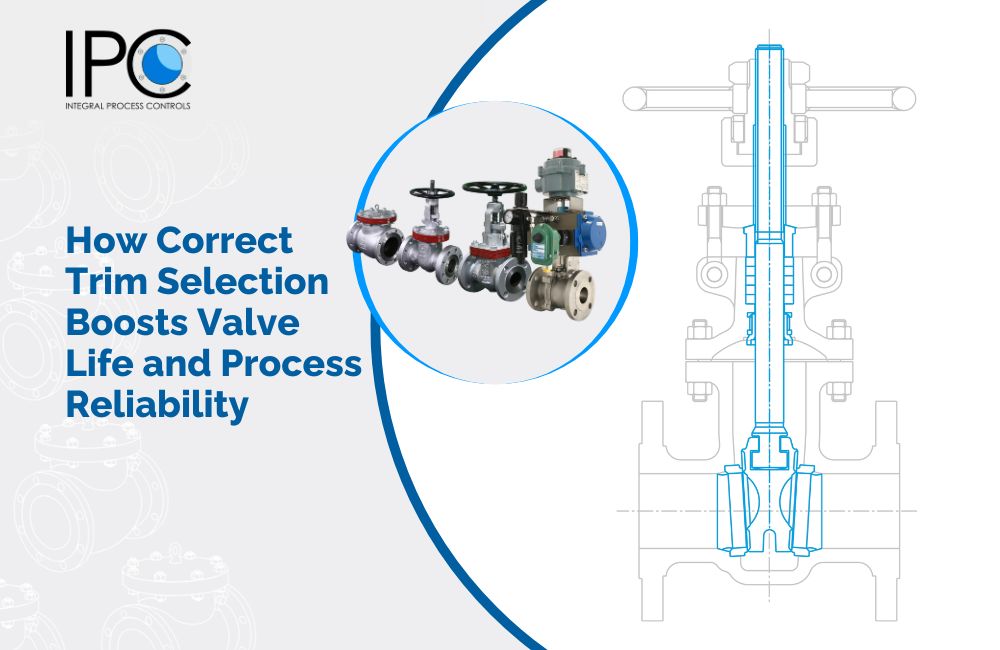Compatibility of trim with media and how IPC recommends trim sets that extend operational life.
What is “trim” in a valve?
“Trim” means the internal parts that actually control the flow and seal. Think disc/wedge/plug, seat rings, stem, back-seat, guides, and any hard-facing on these parts. These pieces see the most punishment pressure drops, velocity, temperature, and the process media itself so getting their material and surface right is the single biggest lever for long valve life.
Why trim selection / choice changes valve longevity
1) Chemistry compatibility = fewer surprises
Media can corrode metals in slow, sneaky ways. Chlorides attack some stainless steels; acids chew carbon steel; sour service (H₂S) needs NACE-compliant metallurgy. Matching trim metal to media chemistry prevents pitting, stress-corrosion cracking, and galling, which means tight shut-off for years, not months.
2) Erosion & cavitation need hard, smooth surfaces
High velocity, flashing, or cavitation turns liquid into a sandblaster. Hard-facing (e.g., Stellite on discs/seats) resists wear, holds shape, and keeps the sealing line smooth so leakage stays low even after thousands of cycles. The added hardness also reduces galling between moving metal parts.
3) Temperature decides what survives
Hot steam, thermal cycling, and low temperatures all change how metals behave. Trim grades with stable hardness and toughness at your operating temperature avoid deformation, wire-drawing, and seal damage.
4) Torque & friction are trim stories too
The wrong pairing of stem vs packing vs seat material can spike friction, driving up actuator size and wearing parts early. The right trim reduces friction, keeps torque predictable, and protects the stem and packing from scoring.
Typical media/issues → Trim approaches (plain language)
- Clean steam / hot condensate: 13Cr stainless (e.g., SS410) with Stellite-faced sealing surfaces for wear and tight shut-off.
- Corrosive water / chlorides: Austenitic stainless (e.g., SS316) or duplex; hard-facing on seats for erosion.
- Hydrocarbons / general refinery service: SS trims with cobalt hard-facing on seating lines to resist wire-drawing and galling.
- Abrasive particles / slurries: Base stainless with thicker hard-facing on disc & seat; consider guided flow paths to cut velocity at the seat.
- Sour service (H₂S): NACE-compliant materials and hardness control; no brittle spots that can crack.
- High-cycle throttling (globe): Erosion-resistant trims and precision hard-facing to keep the seat line crisp.
(Exact grades depend on your spec; the idea is to align metallurgy with media, temperature, and duty.)
How IPC recommends trim selection sets for your process (our friendly, step-by-step way)
1) Start with the real duty, not just the tag.
We ask about media, temperature, pressure, flow profile, solids, and expected open/close frequency. A “water” label can hide chlorides, oxygen, or sand—details matter.
2) Map the likely failure modes.
For each duty we flag the top risks: corrosion, erosion, galling, cavitation, thermal fatigue. This becomes our “failure map” and guides trim choices.
3) Shortlist materials + hard-facing combinations.
We pair base metals (e.g., 13Cr, 316, duplex, Monel, Hastelloy*) with seat/disc hard-facing (often Stellite 6/21) to balance corrosion resistance, hardness, and machinability. If torque is critical, we also look at stem/packing compatibility to keep friction under control.
4) Check standards and compliance.
Where required, we align with API 600/602/603, NACE hardness/chemistry limits, and customer specs. If there’s sour service or oxygen service, we add the right controls and cleanliness levels.
5) Validate the sealing surfaces.
Trim is more than metal grade the geometry and finish on discs/seats decide leakage. IPC maintains accurate seat geometry, Stellite thickness, and fine surface finish to hold a tight, repeatable seal.
6) Document, trace, repeat.
You get trim called out clearly on the datasheet (trim number or explicit materials), with heat traceability. This makes spares and future audits straightforward.
* (Exotics only when truly needed our goal is life-cycle value, not cost escalation.)
Choosing the right trim means the valve keeps sealing cleanly, safely, and predictably with fewer adjustments, fewer leaks, and longer intervals between overhauls. That’s why IPC leads with media compatibility and duty-based trim sets to stretch operational life and protect your process.
Need help matching trim to your media? IPC’s applications team can recommend a set that balances corrosion resistance, hardness, temperature stability, and torque so your valves work the way you expect, for longer.

